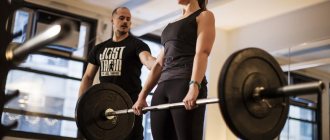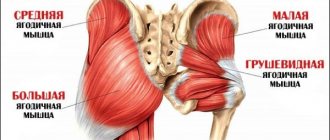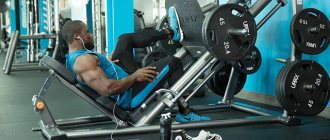Understanding how much you need to exercise in the gym allows you to build an effective workout plan, which will definitely affect your results.
Some athletes believe that training to failure is the best option, so their visit to the gym is delayed by 1.5-2 hours.
Imagine their surprise when they discover colleagues who have achieved the same effect, but study for no more than 1 hour. You can find the “golden mean” only by understanding the physiology of the training process.
A little theory: research on the duration and frequency of training
Frequency and duration are key factors in improving the results of any training. Until recently, athletes believed that one long workout every 7 days on any muscle group gave the greatest effect.
However, recent studies have shown that increasing the number of exercises is more productive, and this is primarily due to the process of muscle protein synthesis.
During training, the muscles are subjected to stress, as a result of which, at the end of training, muscle protein is synthesized most actively.
And here it is worth mentioning the key point, namely the preparedness of the athletes.
The fact is that the period of combining amino acids into protein differs significantly between experienced athletes and beginners. For the former it takes 16-18 hours, but for the latter it can last up to 2 days.
Important! The frequency of training is directly related to the experience of the athlete. For beginners, 1-2 visits to the gym are enough to actively grow muscle mass; trained athletes will find it more difficult to achieve hypertrophy with such a frequency of visits.
As for the duration of the training, it is directly related to changes in hormonal levels during sports. It has been proven that after 45 minutes of intense training, the level of cortisol in the human body increases, which provokes the onset of catabolic processes that destroy muscle tissue. Therefore, trainings that last 40-45 minutes are considered the most productive and safe. The maximum possible time is 1 hour.
Be sure to watch: Lose weight in the gym: the dream or reality of every girl. Training program in the gym for girls. How to use exercise equipment in the gym. Training program for the gym for men: creating an effective set of exercises.
Duration of strength training in the gym
It is important for a novice bodybuilder to know how long a workout in the gym should last if the emphasis is on mass. This time is about 1-1.5 hours. A professional bodybuilder will spend 40–60 minutes on his workout, since he has a specialized program for pumping a particular muscle group.
For beginners, it is important to remember how long a mass workout should last, since they need a basic groundwork. For beginning athletes, there is no strict restriction on rest between exercises and approaches.
If strength training exceeds the maximum limit, cortisol begins to be produced, which destroys muscle tissue. Increased physical activity will lead to overstrain of the body and unpleasant consequences. In any case, you need to understand that you should visit the gym regularly. There will be more benefit from 12 lessons than from 4.
How often should you go to the gym - the optimal number of times a week to get results?
The frequency of exercise is determined by goals. In most cases they are formulated as:
- weight loss;
- strengthening muscles and endurance;
- muscle building.
Cardio training aimed at burning body fat can be done 3 to 5 times a week, as it is quite easy and does not require much recovery time. Another thing is strength training. It is not recommended to carry it out more than 3 times a week, but it is necessary to ensure that after each load the muscle group “rests” for at least 72 hours.
Important! It is worth taking into account individual characteristics and type of constitution. Thus, in mesomorphs with a high recovery rate and strength sensitivity, muscle mass growth will be faster, while in ectomorphs and endomorphs the recovery process will take longer.
Building an ideal training process
To determine for yourself how many times a week you need to go to the gym in order to get optimal results, you need to remember some basic principles (due to which you will be able to squeeze out the maximum that they can give from your workouts).
First of all, these principles relate to the frequency, intensity and complexity of classes.
There are a few more points that should not be forgotten when drawing up a training complex, since it must necessarily include the following types of loads:
- warm-up;
- stretching;
- cool down (cooling muscles).
Now let’s look at each element in more detail and try to find the answer to today’s most important question.
Warm up (warm up muscles) and cool down (cool down muscles)
This type of activity can be safely included in exercise sets, but not performed at such an intense level. For example, if you plan to run on the treadmill for 45 minutes, then you can walk on it at a moderate pace.
Remember, warming up:
- Increases blood flow to muscles;
- Reduces the chances of muscle or joint injury;
- Passes within 5-10 minutes at minimum intensity.
It is important to remember that cooling:
- Prevents blood from pooling in the extremities;
- No more than 5 minutes pass (the intensity level should gradually decrease).
Stretch marks
You need to stretch your muscles both after the warm-up and after the cool-down. Its role is very important, since it is thanks to stretching that the risk of injury is reduced, and the feeling of stiffness after exercise disappears and at the same time flexibility develops.
Important : A very common mistake is to stretch before warming up. Such actions are fraught with injury, since the muscles first need to be warmed up and only then stretched.
How often should you train?
People are advised to be active daily and do light aerobic exercise 3-5 times a week (cycling, swimming, brisk walking). Those who lead a sedentary lifestyle need to get used to working out in the gym gradually, starting from 2 times a week.
The most effective way to work would be:
- Monday – training in the gym;
- Tuesday – aerobic exercise;
- Wednesday is a day of rest;
- Thursday – classes in the hall;
- Friday – aerobic exercise;
- Saturday and Sunday are rest days.
The purpose of our site is to provide qualified assistance in drawing up training plans. Go to the section with ready-made workouts or order an individual training plan from a specialist!
How long should you train?
According to scientists, a person should spend at least 20 minutes a day on sports (warm-up and cool-down are not taken into account). The maximum interval between exercises is 1 hour. For those who are just starting to go to the gym, it is important to first increase their time under load from 10 minutes to 20-25 minutes. It's best to start with exercises that you can do at home, such as push-ups, squats, abs, etc.
How difficult should it be?
Some athletes in the gym work hard, so their training time stretches over long periods, while others, on the contrary, work with high intensity and therefore invest in a record time. So it turns out that intensity is an important factor that influences the amount of time required, the intervals between classes and the number of approaches.
Beginners are advised to start with low-intensity physical activity. After this, you need to gradually increase the duration of training (the total amount of time under load), and only then can you increase the intensity.
Each athlete must determine for himself how often and for how long to train. This figure is flexible enough in itself, so everyone has everything they need to derive the optimal value.
So it turns out that to answer the question of how many times you need to visit the gym, you must first analyze all the parameters listed above, and then come up with something that is suitable for you.
There is an option to take the simple route and give instructions to train everyone and everything for one hour 3 times a week. Only the results from this approach will be small. And why all? Yes, because there is no adjustment in them to their goals, their body and their daily routine.
Now is the time to move on to considering the physiological side of training.
Is it possible to train every day?
Until recently, daily training for different muscle groups was considered the norm for many athletes. However, practice has shown that neither muscle tissue nor the nervous system had time to cope with stress. As a result, the productivity of the training process decreased, and the effect of overtraining occurred.
The time required for recovery depends on several indicators:
- athlete experience (a beginner needs more, a professional needs less);
- type of muscles (small ones recover faster, large ones - slower);
- muscle groups (biceps and triceps can be trained more often, legs - less often).
The following recommendations resulted from research and practical experience:
- Beginner athletes – 3 times a week.
- Experienced athletes – from 4 to 5.
At the same time, you should not load the same muscle groups more than 2 times a week.
Suitable options for weight loss
How many times a week girls need to train depends on the goal. If to maintain shape, then two or three times are enough, but if the goal is to get rid of excess weight, then the more training, the better. But not all types of physical activity are equally suitable for getting rid of excess body weight.
The best options are so-called cardio exercises, or aerobic exercises.
These could be the following options.
Cardio training
They consist of a set of exercises that are performed without weights. It is quite possible to perform these complexes at home; it is not necessary to visit the gym for such exercises.
Walking at a fast pace
It is well suited for accelerating metabolic processes, and is also safer than running for people with diseases of the spine, knees and other joints of the lower extremities. Also well suited for preparing weak ligamentous apparatus for running and other types of loads. Interval options are especially effective - alternating faster and slower paces, as well as moving over uneven terrain.
Run
More effective, but also more demanding on shoes, as well as the condition of the musculoskeletal system.
Swimming
Ensures the work of almost all muscles of the body, while ensuring extremely low stress on the joints. This is the most suitable option for obese people, as injuries are least likely here.
Best hours for sports: morning, afternoon, evening
Human physiology and vital activity are associated with the phenomenon of circadian rhythms. At its core, these are fluctuations in natural biological processes, for example, body temperature, hormone levels, and blood pressure. Human activity, including motor activity, depends on these indicators.
The answer to the question of when is it better to go to the gym: in the morning or in the evening, is closely related to the type of training. Thus, in the morning hours there is a significant production of cortisol, which is responsible not only for quickly waking up, but also for mobilizing strength during physical activity. The best option for exercise at this time is cardio training. Due to cortisol, metabolism accelerates and energy expenditure increases significantly.
Some athletes prefer to go to the gym in the afternoon. And this is also facilitated by circadian rhythms. During the period from 16.00 to 18.00, most people experience a slight increase in body temperature. As a result, the muscles are warmer, more elastic and prepared for work. At this time, anaerobic exercise will be effective, including due to increased endurance and reduced risk of injury.
In the evening, you should not resort to heavy muscle-building exercises or intense aerobic exercise. This will affect the quality of sleep and disruption of the immune system. Most often, it is at this time that people do relaxing yoga or breathing exercises.
How long should the workout last?
The question of what time is best to go to the gym is related to the question of how long you can exercise. Here it is worth turning again to physiology. During physical activity, the body produces 2 types of steroid hormones: catabolic and anabolic. The first are represented by testosterone, somatotropin and insulin. Their task is to restore muscle fibers and build new muscle tissue cells.
The second group is cortisol and glycogen, which increase blood glucose levels and “stimulate” metabolism. Glycogen, at its core, is a storage facility for glucose; it is found both in the muscles and in the liver. During the first 20 minutes, the body takes it from muscle tissue, and then begins to “extract” it from the liver.
Important! After 40-45 minutes of active training, cortisol levels increase, which in excess is more harmful than beneficial. It reaches its maximum values at 55-60 minutes of training. At the same time, blood pressure begins to rise and immunity deteriorates. Intense production of cortisol for more than 60 minutes has the opposite effect, as muscle tissue begins to break down.
Therefore, sports and medical experts strongly advise not to overtrain and not work in the gym for more than 45-60 minutes.
How long after the start are results visible?
Sport is not plastic surgery, where immediate results are visible immediately after the operation. The visual results of regular exercise will become noticeable only after 10-12 weeks of training. At the same time, you need to train at least 3 times a week for the results to become noticeable.
If your goal is to lose weight, then it makes sense to alternate cardio with moderate strength training. In the case of gaining muscle mass, it is necessary to draw up a plan taking into account the muscle recovery period, which should not be less than 72 hours.
In both cases, you will need to organize a balanced diet that meets the goals of the exercise.
The main features of training aimed at reducing body weight
How many times a week should you exercise to lose weight? In cases where the main goal is to reduce excess body weight, the more often you train, the better. The minimum amount is three times a week, but for quick results you can do it daily.
Such training has its own characteristics:
- It is necessary to increase the frequency and intensity smoothly, without creating a stressful situation for the body.
- The best time of day is morning, since in this case the load will fall on the natural peak of the production of many hormones, as a result of which energy consumption will increase by about twenty percent compared to the evening.
- There is no particular point in aerobic exercise lasting less than half an hour; the optimal duration is considered to be about an hour. However, if desired and possible, you can practice longer.
- It is better not to eat an hour before and an hour after training in order to reduce body weight. Eating can negatively affect the breakdown of adipose tissue, since first of all, during and also after physical activity, it is the calories from the last meal that will be used, and not from the sides.
The intensity of exercise is very important if the goal is to burn excess fat tissue. In the case of aerobic exercise, its intensity is closely related to heart rate.
The optimal heart rate range is calculated using formulas; in the calculation, age, gender, and body weight are of greatest importance.
To reduce body weight by getting rid of excess adipose tissue, aerobic exercise is best suited; strength training will not bring the desired result if the goal of the exercise is weight loss.
What results can you realistically achieve?
Despite the fact that the most obvious results can be summed up only after 3 months, intermediate results can begin to be tracked much earlier.
So, after two days, the body, unprepared for sports, will make itself felt with unpleasant muscle pain. To minimize pain, you must not forget about the warm-up, which reduces the risk of injury for beginner athletes, and the final stretch, aimed at facilitating the process of muscle tissue recovery.
These pain sensations bother you after the first 2-3 sessions, after a couple of weeks, all muscle pain will go away. The main thing is not to stop training during this period.
Physical well-being will improve significantly 4 weeks after starting to visit the gym. It will become easier to get up in the morning, shortness of breath will disappear, muscles will stretch better, and most exercises will be easy to do. During this period, visceral fat, which is located near the internal organs, is burned. After this, the turn will come to the subcutaneous.
After 2 months, the body will gradually begin to change shape, the risk of heart disease will decrease, as well as blood sugar levels, which will significantly reduce the possibility of developing diabetes.
After 3 months, it will be possible to visually evaluate the results achieved. They will be noticeable to others. Muscle relief will appear or improve, and some of the subcutaneous fat will disappear. The silhouette will become slimmer, fitter and more beautiful.
Pro Tips
Ekaterina Usmanova, current Russian fitness bikini champion, video blogger
Ekaterina strongly recommends supplementing strength training with cardio blocks, combining everything into interval training, which, while maintaining the proper pace, should not exceed 1 hour.
Denis Borisov, video blogger, author of articles on bodybuilding, one of the creators of the Fit4life.ru project
Denis recommends that beginners who are committed to the process of gaining muscle mass should exercise no more than 3 times a week, for at least 1-1.5 years. In addition, the duration of training, depending on the plan, should vary from 30 to 60 minutes.
Ilya Timko, fitness trainer, creator of the website Tvoytrener.ru
“The more often you train, the shorter the sessions should be,” says Ilya. So, for example, if the training was 2 times a week for 1.30, and then the athlete switched to 4 classes a week, then the training time should be reduced by about 30%, that is, to 60-70 minutes maximum.”
How many times a week should you train your muscles?
Good day, dear readers! In this article I want to share with you information regarding one interesting experiment that I conducted quite recently and it lasted exactly one month. By the way, in the previous article, I talked about another similar experiment in which I tried to determine what works best for muscle volume in the range of 6/12 repetitions with higher and lower weights, I highly recommend reading the article. So, this time another goal was set: to determine how many times each muscle group needs to be trained for best growth, 1 or 2 times a week.
I have heard more than once that a muscle group can be trained every 48 hours, but how many of you train all muscles 3-4 times a week, again, each muscle group 3-4 times a week. This is due to the fact that the increase in protein synthesis in the body in response to a training stimulus increases for two days, after which it begins to decrease. If after 48 hours there is no stimulating effect on the muscles, protein synthesis in the body decreases and muscle growth slows down.
By the way, about 10 years ago, after reading such information, I began to practice frequent training and reached 4-5 times a week. But this didn’t make me feel better, and even worse, because... strength began to fall and muscle growth stopped, because... I just didn’t have time to recover. Perhaps, if you don’t work physically at all, eat ideally and sleep 12 hours a day, the result would be positive, but putting sports as a priority as the most important task in life is at the very least stupid, especially if you don’t make money from it, but only you spend. But last year I watched a video of a famous trainer, where he compared muscles with calluses, saying that the more often you rub a callus, the larger and harder it will be, the same with muscles. “In principle, it’s logical!” I thought, because this was a really good example.
After a long break from sports of several months (winter) and not following a proper diet, I decided to return to sports. But because I am recovering quickly, it was decided to conduct this experiment for clarity. This time I did the ideal conditions for the muscles, namely, I trained only my arms and legs and nothing else. Concentrating only on these muscle groups, because it is not possible to measure the back or chest separately. I wanted to know for sure whether the frequency of applied loads works or whether the great Mike Mentzer was right in his books by practicing infrequent training.
So, on January 16, the experiment was started, my measurements after a long break and poor nutrition were as follows:
LEFT SIDE Left arm - 34.5 cm Left forearm - 27.5 cm Calf muscles - 34 cm Thigh muscles - 50.5 cm
RIGHT SIDE Right arm – 35 cm Right forearm – 27.5 cm Calf muscles – 34.5 cm Thigh muscles – 50.5 cm
I split my body into two parts, training the left side twice a week and the right side once a week. The number of approaches and repetitions was standard, namely 3-4 6-12 times. After a month of such training, I took measurements again and the results were as follows:
LEFT SIDE Left arm - 35.4 cm Left forearm - 28.1 cm Calf muscles - 34.5 cm Thigh muscles - 52.5 cm
RIGHT SIDE Right arm – 35.5 cm Right forearm – 27.8 cm Calf muscles – 35 cm Thigh muscles – 51.5 cm
Now there's a clear difference:
- The left hand has increased by almost a centimeter, and the right hand has increased to the floor - the difference is almost double.
- The left forearm has increased by 6 millimeters, and the right by 3 - the difference is also twofold.
- The calf muscles have equally increased in volume, there is parity here.
- And the most interesting thing is the thigh muscles, a difference of a whole centimeter is the same twofold increase.
Following the numbers, we can conclude that frequent training (2 times a week) really works better than less frequent training (1 time a week), but here it is worth understanding that in order for there to be really good progress in this case, you need to create appropriate favorable conditions. conditions. I don’t think that if you train absolutely all your muscles twice a week, the result will be the same, especially if you work physically at your job, and even more so if your nutrition and recovery are mediocre.
But where I would definitely use this method is on lagging muscles. I see this method as the most appropriate in our everyday realities. Therefore, if you have lagging muscles, try to change something in your training, for example, the frequency of training, but only wisely. And I think this should play a positive role. Well, whether or not to use this method is up to you to decide, however, share your opinion in the comments on this matter, it will be interesting. That's all, good luck everyone!
If you find an error, please select a piece of text and press Ctrl+Enter.
Main conclusions
The frequency and duration of training directly depends on the physiology of a person and his goals:
- The optimal number of trips to the gym: no more than 3 times for beginners and no more than 5 times for professionals.
- The duration of sports should not exceed 1 hour.
- Daily training is harmful to both the muscular and nervous systems.
- The first results of working on yourself will become noticeable after 10-12 weeks.
The effectiveness of training depends not only on the effort put in, but also on a balanced, well-chosen diet.











